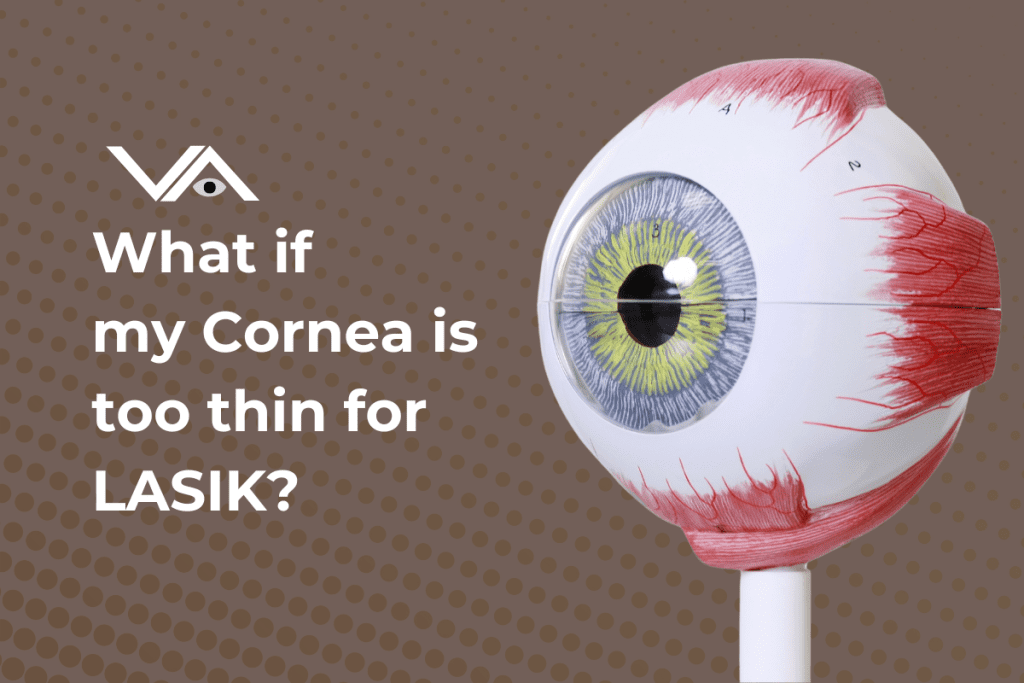Table of Contents
ToggleAlthough your corneas aren’t sufficiently thick for LASIK, alternative corrective surgeries can help you stop wearing eyeglasses. The depth of the cornea is one of the numerous unique procedures carried out throughout a refraction checkup to ensure that you’re an appropriate candidate for LASIK. The usual spectrum for the depth of the cornea may vary from as low as 470 microns up to as dense as 630 microns, while the median ocular depth lies between 520 and 540 microns. So, What If My Cornea Is Too Thin for Lasik?.

Candidates for LASIK must have sufficient tissue in their corneas to create an incision, remove the necessary amount of muscle to fix their refractive errors, and retain sufficient corneal tissue to prevent corneal ectasia or continuous expansion of the cornea.
LASIK is probably not the ideal treatment for you if your cornea needs to be sufficiently thick to produce a corneal mattress or the portion of the cornea still visible below the flap has a thickness of about 300 microns. The doctor does estimates throughout a visual exam to make certain the cornea is sufficiently broad for LASIK.
Myopia, hyperopia, and astigmatism can all be treated with this corrective procedure without changing the dimension of the cornea.
Can corneal thin be treated? What If My Cornea Is Too Thin for Lasik?
Yes, thin cornea can be treated though you may require a cornea transplant for severe corneal erosion or damage. Your optometrist may advise replacing all or a portion of the cornea with viable donated cells based on your circumstances. Laser keratoplasty is another name for corneal transplantation.

Is LASIK safe for thin corneas?
Lasik is safe for thin cornea, and several studies support this claim. Thin corneas were once considered a contraindication for Lasik surgery, but this is no longer the case with the advancement of technology and surgical techniques.
With the use of customized ablation algorithms and femtosecond lasers, Lasik can now safely and effectively correct refractive errors, even in patients with thin corneas.
Additionally, the use of corneal cross-linking before or after Lasik can further enhance the safety and stability of the procedure. Therefore, thin corneas should not concern those considering Lasik surgery.
What Lasik Options Are Available Instead?
Additionally, safe surgical alternatives can remove the requirement for eyeglasses or contacts even though you were told that you are not an approved fit for LASIK. Among the various vision repair techniques that doctors provide is LASIK. You might be eligible for any of these surgeries if you’re not a LASIK fit.
LASEK: Advance Surfaces Ablation
As a substitute for LASIK eye surgery, Advanced Surface Ablation, sometimes referred to as LASEK, serves as a correcting laser vision treatment. LASEK does not include making a piece of tissue to modify the cornea, similar to LASIK.
A number of the most crucial LASIK procedures is making an opening; however, for certain individuals, particularly ones with weak corneal cell membranes, it may result in difficulties. A femtosecond laser makes a tiny flap in the corneal after LASIK.
An excimer laser completely restores the cornea using short bursts of ultraviolet (UV) radiation once the membrane is cut back. The opening is then removed, returned to its normal location, and let to heal naturally after the cornea has been reshaped. No dressings or staples are applied. Throughout LASEK, a concentrated alcohol fluid is used to relax the epithelium, the cornea’s front topmost membrane. Afterward, it is shifted in the opposite direction.
The epithelium cannot be removed during LASEK, contrasting PRK, an additional procedure where it borrows parts. Rather, it has been relaxed but remains fastened. The epithelial membrane is then placed back in its initial position after the excimer laser has been used to treat the corneal surface beneath the epithelium. This process is comparable to LASIK.
Its epithelial flap is subsequently secured back in location, and the cornea is covered with a soft lens for contact. The early stages of mending manage to render the eye feel better. If you suffer from chronic dry eye conditions, weak corneas, or epithelium dystrophy, LASEK might be a preferable surgery for correcting your eyesight.
PHAKIC IOL
A PHAKIC IOL can be a superior refractive choice if the cornea isn’t sufficiently thick. It removes the requirement for glasses or contact lens-corrected vision. The FDA has approved the Implantable Collamer Lens to treat myopia between -3.00 D and -15.00 D. To rectify the optical mistake, a tiny lens graft is inserted within the eye. It is ahead of the native lenses, along with an iris (colored region of the eye).
The depth of the cornea remains unchanged, unlike with LASIK. Subsequently, the contact lens is made to remain in place in the cornea with no additional maintenance. Those below the age limit 45 are ideal for this laser vision correction technique.
The quality of a person’s vision is another variable that could prevent them from becoming successful LASIK applicants. Even nearsightedness as much as -11.00 diopters, astigmatism up to 5.00 diopters, and farsightedness up to +5.00 diopters can be corrected with LASIK utilizing excimer the use of lasers according to the FDA.
An additional tiny flap, again in the cornea, is made between one and two weeks following the ones near the iris have been made. This channel is used for putting in the folding lens. The four outer edges of the eyepiece are then positioned above the iris after the lenses have unfolded. You can render the lens unseen to you and everybody around by positioning the optics’ corners below!
Individuals with weak corneas or dry eye conditions and not candidates for conventional vision-correcting laser treatments may benefit most from a Phakic IOL.
Exchange of Refractive Lenses
Refractive Lens Exchange (RLE), in contrast to a Phakic IOL, uses an IOL to treat optical problems. It allows clients to preserve their native lenses. In other words, the normal lens is removed, and an optical implantation called an IOL is put in its stead. Apart from a single modification, RLE and cataract surgery are very similar. Clients’ clouded lenses are removed and substituted with IOLs during cataract surgery.
There are, however, no hazy lenses with RLE.
In contrast, the lens usually goes away while still being transparent. It is subsequently substituted with a synthetic lens to lessen the need for eyeglasses or contacts. RLE is often carried out in a single eye at once, given a full week or more afterward, similar to cataract surgery.
Those who require surgery to relieve pressure in their eyes have premature cataracts. Or else, those with serious farsightedness frequently require a corrective lens swap. Regardless of your reasons, RLE is a fantastic choice if you want to stop wearing glasses or contacts permanently.









